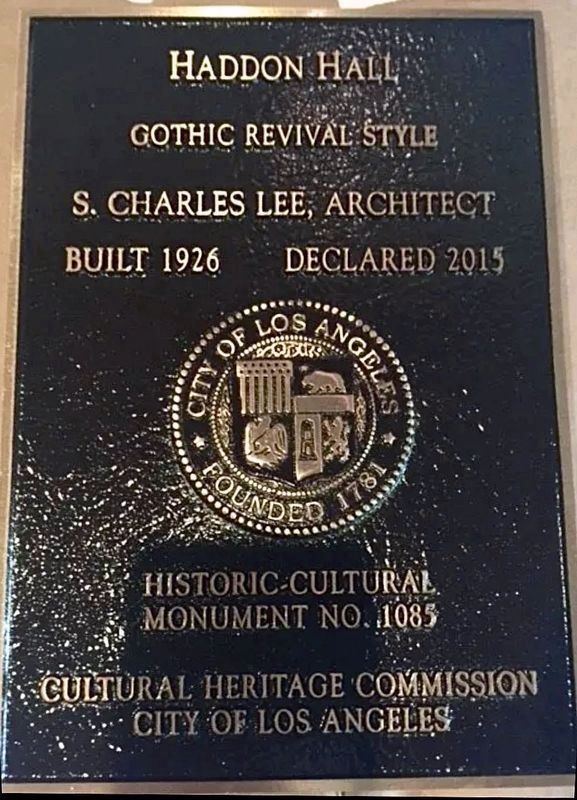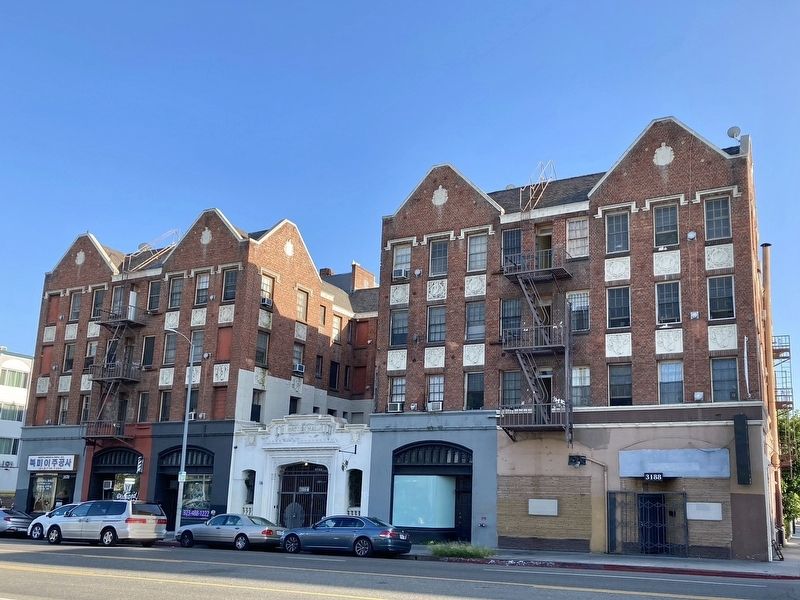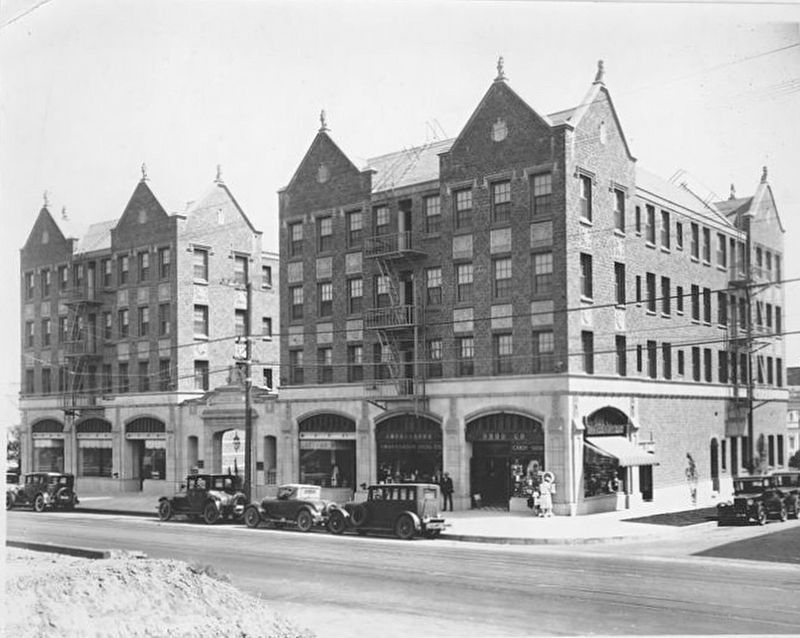Koreatown in Los Angeles in Los Angeles County, California — The American West (Pacific Coastal)
Haddon Hall
Erected 2015 by City of Los Angeles. (Marker Number 1085.)
Topics and series. This historical marker is listed in these topic lists: Architecture • Industry & Commerce. In addition, it is included in the Los Angeles Historic-Cultural Monument series list. A significant historical year for this entry is 1926.
Location. 34° 3.457′ N, 118° 17.839′ W. Marker is in Los Angeles, California, in Los Angeles County. It is in Koreatown. Marker is on 8th Street east of Normandie Avenue, on the right when traveling east. Touch for map. Marker is at or near this postal address: 3184 W 8th St, Los Angeles CA 90005, United States of America. Touch for directions.
Other nearby markers. At least 8 other markers are within walking distance of this marker. Founder’s Church (approx. half a mile away); Wilshire Boulevard Temple (approx. half a mile away); Bullocks Wilshire (approx. 0.6 miles away); Wiltern Theatre (approx. 0.7 miles away); First Congregational Church (approx. 0.8 miles away); Felipe de Neve Branch Library (approx. 0.9 miles away); U.S.S. Maine Memorial (approx. one mile away); Los Angeles City Cemetery (approx. one mile away). Touch for a list and map of all markers in Los Angeles.
Regarding Haddon Hall. Haddon Hall is significant for its distinguished architecture in a Late Gothic Revival style designed by prominent Los Angeles architect S. Charles Lee. Active from the 1920s through 1950s, architect S. Charles Lee (also known as Simon Charles Levi, 1899-1990) is known primarily for his movie palaces. Blending historical fantasy and modern functionality became the hallmarks of Lee's prolific career, which came to fruition with his designs for movie theaters in the 1930s and 1940s. Other designs by this architect include: Tower Theater (1927) LAHCM #450, Hollywood Western Building (1928) LAHCM #336, Los Angeles Theater (1931) LAHCM #225, Fox Bruin Theater (1937) LAHCM #361. Haddon Hall, completed in 1926, is notable as one of Lee's first grandly scaled buildings to explore Period Revival styles, paving the way for his movie theater designs. Like Lee's later theaters, Haddon Hall was designed to be a functional space that transported residents to a different place and time, standing out from the generic urban streetscape as a balance of fantasy and functionality.
Haddon Hall was commissioned by stockbrokers Robert and James Oberndorf in 1926. At the time, the Wilshire-Pico District was a desirable location for apartment hotel type investment properties. Following the success of the Ambassador Hotel (opened in 1921), this area emerged as a district of dense tourist and residential development in the 1920s. The Oberndorf brothers sold Haddon Hall in 1927, almost immediately after its completion, but maintained an office for their stockbroker business in the building until 1932.
Named after a manor house in England and stylistically inspired by its namesake's Gothic architecture, Haddon Hall epitomizes the Late Gothic Revival style. Late Gothic Revival style, popular from the late 1910s through 1930s, is characterized by brick, concrete, and terra cotta used to replicate design elements derived from medieval castles and cathedrals in Northern Europe. Haddon Hall exhibits many character-defining features of the style. A steeply pitched cross-gable roof with gable ends articulated through contrasting materials emphasizes verticality. Windows with diamond panes and doors are set in ogee-arched openings. Other character-defining features include coats of arms in stained glass and decorative spandrel panels. The original arch enclosing the entry court with fountain (now partially altered), provided a theatrical entrance, transporting residents into the Late Gothic theme as it continued to the interior of building. The first floor lobby mimicked the entry hall of an English manor house with low ceiling, painted panels, chandeliers, and decorative wood surrounds framing doorways and key desk.
Haddon Hall was a "deluxe" building with decorative public rooms and efficient apartments, operating as an apartment hotel with rooms suited to the short- and long-term stays. In addition to its Late Gothic architectural details, Haddon Hall was technologically innovative. Lee was particularly proud of its central refrigeration system, which chilled water with ammonia, pumping it through insulated pipes to create cold cabinets in individual apartments.
-from planning.lacity.org
Credits. This page was last revised on October 3, 2023. It was originally submitted on August 8, 2023, by Craig Baker of Sylmar, California. This page has been viewed 302 times since then and 258 times this year. Photos: 1, 2, 3. submitted on August 8, 2023, by Craig Baker of Sylmar, California.


